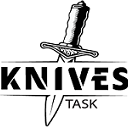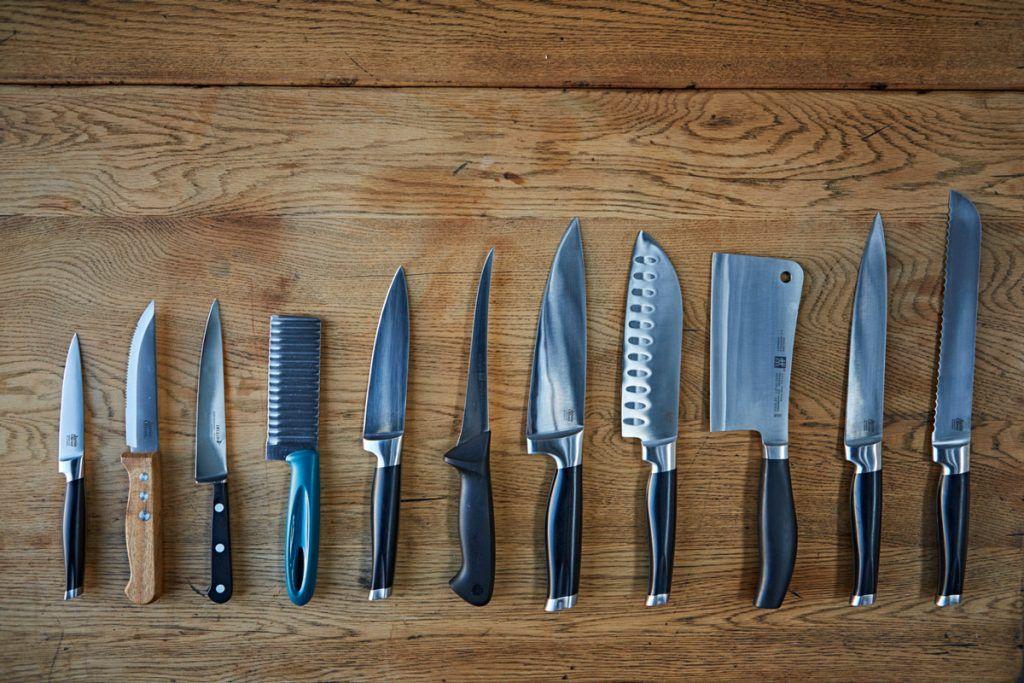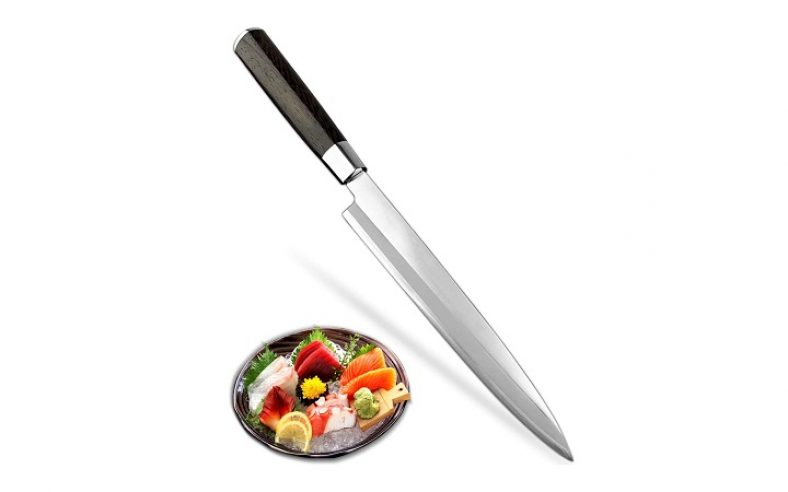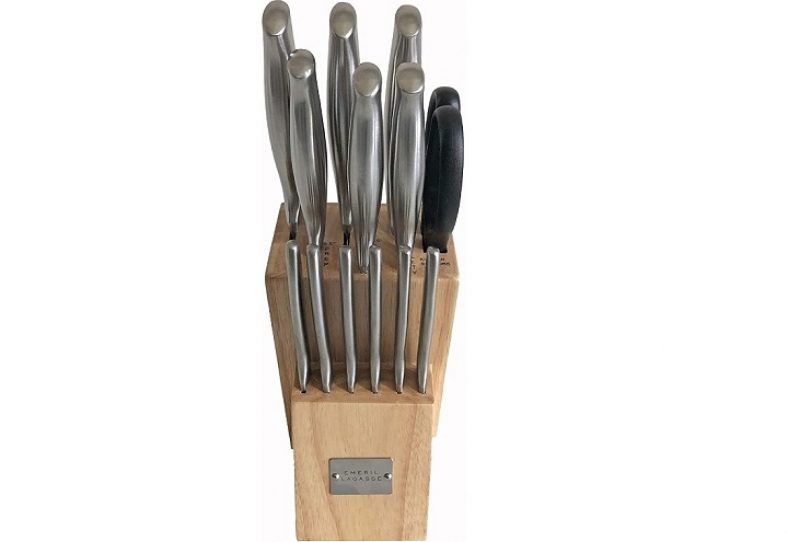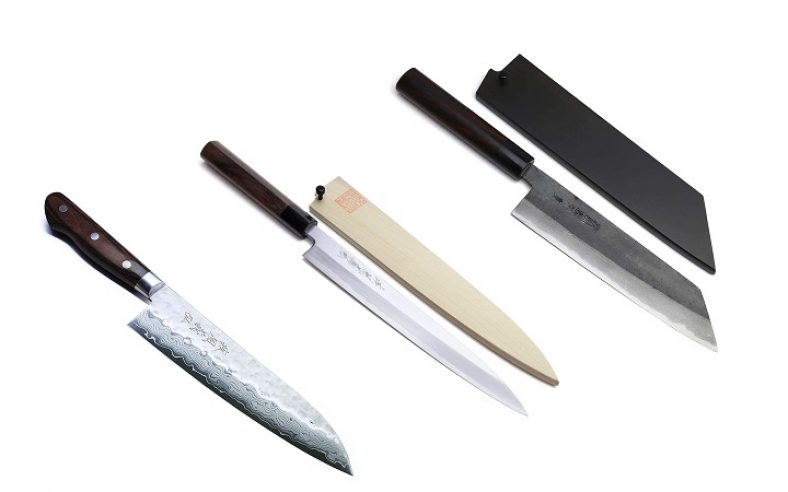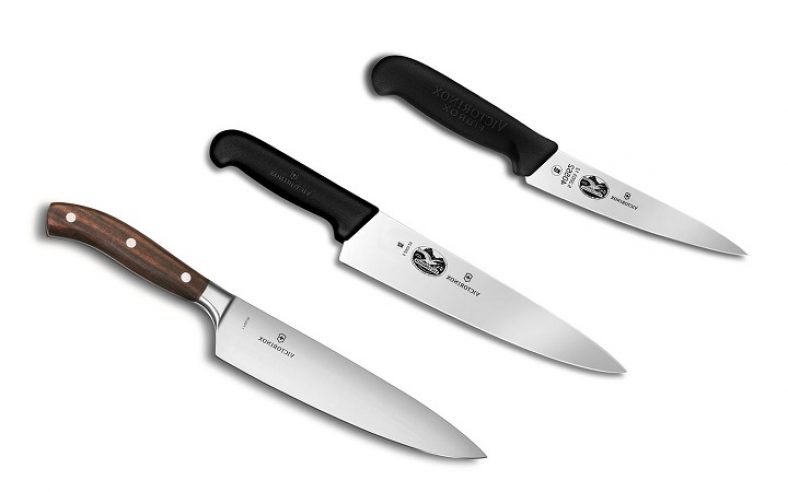Every kitchen should have a chef’s knife, a paring knife, and a bread knife. These knives are essential for a home cook to prepare most dishes efficiently.
A well-equipped kitchen requires the right set of knives for cooking. Whether you’re an amateur or a professional chef, selecting the right knives can make a significant difference in the quality of your food. With the right type of knives, you can handle any task with ease, from peeling and slicing vegetables to carving meats.
These knives are the backbone of your kitchen and can contribute to the success of your culinary skills. In this article, we’ll discuss the must-have knives for a home cook, along with their uses, benefits, and why you need them in your kitchen.

Credit: www.webstaurantstore.com
Understanding Knives: Basic Knife Anatomy
Every kitchen needs an array of must-have knives to help make meal prep a whole lot easier. However, before delving into the types of knives and their uses, it is imperative to understand the anatomy of a knife. Here, we will break down the different parts of a knife, types of blades, handle materials, and blade materials you need to know as a beginner or professional chef.
Parts Of A Knife
Knowing the parts of a knife delivers enlightenment on how each knife works and helps identify its suitability for certain kinds of cuts. Here are the parts of a knife:
- Blade: The main cutting part
- Tip: The pointed end of a blade
- Edge: The cutting surface along the blade
- Heel: The thickest part of the blade, used for cutting through hard foods
- Spine: The thickest part of the blade opposite the edge
- Bolster: The junction between the blade and handle, providing balance and support
- Tang: The part of the blade that runs through the handle
Types Of Blades
Knives are differentiated by their blade shapes, which determine their particular function. Understanding the different types of blades helps you select the best one for the task at hand. Here are the most common types of blades:
- Chef’s knife: A multi-purpose knife used for chopping and slicing fruits, vegetables, and meat.
- Paring knife: A small knife used for peeling and trimming fruits and vegetables.
- Bread knife: A long knife with a serrated edge used for slicing bread.
- Fillet knife: A flexible knife used for filleting fish.
- Santoku knife: A japanese knife similar to the chef’s knife, but with a straighter blade and a granton edge, which prevents food from sticking to the blade.
- Cleaver: A large and heavy knife used for chopping meat and bones.
Handle Materials
Knife handles come in various materials, including wood, plastic, rubber, and metal, among others. Choosing the right handle material ensures maximum comfort, grip, and durability when using the knife. Here are the most common handle materials:
- Wood: Adds an elegant and classic look to the knife, but requires special care to prevent warping, cracking, or contamination.
- Plastic: Water-resistant and easy to clean, but may be slippery when wet.
- Rubber: Non-slip and easy to grip, but not as durable as other materials.
- Metal: Durable and easy to clean, but may get slippery when wet.
Blade Materials
The blade material determines the sharpness, strength, and longevity of the knife. Different materials may offer different advantages, so it is essential to consider your specific needs and budget when choosing a blade material. Here are the most common blade materials:
- Stainless steel: Corrosion-resistant and easy to maintain, but may not hold an edge as long as other materials.
- High-carbon steel: Durable and holds a sharp edge, but may require more maintenance to prevent rusting.
- Ceramic: Lightweight and holds an edge well, but may be brittle and prone to chipping if not handled carefully.
Understanding the parts of a knife, types of blades, handle materials, and blade materials are essential for selecting the best knives for your kitchen. With this knowledge, you’ll be able to make more informed decisions and get the most out of your knives, whether you’re a beginner or a seasoned chef.
Kitchen Knife Categories
As a home cook or professional chef, having the right set of knives is essential for preparing meals efficiently. Kitchen knife categories can be broken down into several types, each serving a unique purpose. Let’s take a closer look at each of them.
Chef’S Knife
The most important knife in any kitchen is the chef’s knife. This multi-purpose tool is ideal for chopping, dicing, slicing, and mincing. The blade should be at least 8 inches long, and the knife should have a slightly curved blade, allowing for a natural rocking motion while chopping.
When choosing a chef’s knife, look for one made with high-quality materials, such as stainless steel or carbon steel. Comfortable handles, such as those made from wood or rubber, are also critical for extended use.
Serrated Knife
A serrated knife has a long, jagged edge, making it ideal for cutting through hard or tough items, such as bread, tomatoes, or citrus fruits. When choosing a serrated knife, look for one with a sharp, sturdy blade and a comfortable handle that allows for a firm grip.
Paring Knife
A paring knife is a small, versatile knife that is ideal for peeling, trimming, and cutting small fruits and vegetables. The blade should be between 2 and 4 inches long, with a sharp, straight edge. Look for a knife with a comfortable handle, as this knife may be used for extended periods.
Utility Knife
A utility knife is a mid-sized knife that is ideal for a variety of tasks, such as cutting meat, slicing cheese, or trimming vegetables. A sturdy blade with a sharp edge is essential for effective use of a utility knife.
Additionally, a comfortable handle is crucial for extended use.
Bread Knife
A bread knife has a long, serrated blade, making it perfect for slicing through bread without crushing it. When choosing a bread knife, look for one with a sharp, sturdy blade, and a comfortable handle.
Boning Knife
A boning knife is a long, thin blade that is ideal for deboning meat and poultry. The sharp, pointed tip of the blade allows for precision cuts, while the comfortable handle provides an excellent grip.
Cleaver
A cleaver has a broad, rectangular-shaped blade, making it ideal for chopping through large cuts of meat or bones. When choosing a cleaver, look for one with a sturdy blade and a comfortable handle that provides a good grip.
Having a set of high-quality knives is essential for any home cook or professional chef. By understanding the different types of kitchen knife categories, you can choose the right knife for the task at hand and prepare meals efficiently.
How To Choose The Right Knife
Considerations For Choosing The Right Knife
Choosing the right knife for your kitchen can be daunting, especially if you’re not familiar with the different types. When selecting a knife, there are several factors you should consider to ensure you get the best one for the job.
Here are some things to keep in mind:
- Purpose: Consider what tasks you’ll be using the knife for. Do you need it for chopping vegetables, slicing meat, or deboning fish? Different types of knives are designed for specific purposes.
- Blade material: The blade material can affect the knife’s durability, sharpness, and ease of maintenance. Stainless steel is a popular choice for its rust-resistant properties, while carbon steel is known for its sharpness retention.
- Handle: The handle should feel comfortable and secure in your hand to prevent slippage and potential injury. Look for a handle that provides a firm grip, with no gaps or rough edges.
- Size and weight: The size and weight of the knife can impact the ease of use and precision of cuts. Consider the size of your hand and the weight you’re comfortable handling.
Common Mistakes To Avoid
When purchasing a knife, there are some common mistakes that you should avoid. Here are a few to watch out for:
- Going for quantity over quality: While a knife set with numerous pieces can be tempting, it’s better to invest in a few high-quality knives. A cheaper set may not hold up well over time and could need frequent replacements.
- Not doing research: Before purchasing a knife, it’s important to read reviews and do some research. A knife may look good on paper, but customer reviews can give you valuable insight into its performance.
- Not maintaining the knife: Proper maintenance is crucial for extending the life of your knife. Be sure to sharpen the blade regularly and clean it properly after each use.
Knife Maintenance And Care
Proper care and maintenance of knives are essential for ensuring their longevity and performance. Here are a few tips to keep your knives in top shape:
- Use a honing rod: A honing rod can help keep your blade aligned and sharp by straightening out dull edges.
- Clean the blade immediately after use: Rinse the blade with warm water and soap immediately after use to prevent the buildup of food particles and bacteria.
- Store knives properly: Store knives in a designated block or on a magnetic strip to protect the blade from wear and tear.
- Sharpen regularly: A sharp knife is safer and more efficient to use than a dull one. Use a sharpening stone or electric sharpener to keep your knife’s blade in top condition.
Choosing the right knife for your kitchen is an important decision that can impact the quality and efficiency of your cooking. By considering the purpose, blade material, handle, size, and weight of the knife, avoiding common mistakes, and properly maintaining your knives, you can ensure that they will serve you well for years to come.
The Importance Of Quality Kitchen Knives
A kitchen without knives is hard to imagine. Knives are an essential part of cooking, but not just any knife will do. Using quality kitchen knives can change the way you feel about cooking for the better. Here’s why:
Benefits Of Using Quality Knives
When it comes to using quality kitchen knives, there are many benefits to enjoy:
- Precision: Quality knives are often sharper and more precise than lower quality options. This allows you to cut, slice, and chop with ease, reducing accidents and injuries.
- Comfort: Good knives feel comfortable in your hand. They are well-balanced and made with materials that do not strain your wrists or fingers. This means you can use them for more extended periods without causing fatigue.
- Durability: High-quality knives can last for years if they are well taken care of. Not only does this save you money in the long run, but it also means you won’t have to replace your knives often.
- Versatility: Quality knives can be used for various tasks in the kitchen, from slicing through tough meat to dicing soft vegetables. Having a selection of good knives can make food preparation a breeze.
Investing In Good Knives
Investing in quality kitchen knives may seem like an unnecessary expense, but it’s a decision you won’t regret. Here’s why:
- Efficiency: Using quality knives can make food preparation more efficient. You can work faster and with more accuracy, saving you time and allowing you to focus on other aspects of cooking.
- Safety: Poor quality knives can cause accidents, putting you at risk of injury. Investing in quality knives reduces the chance of this happening, keeping you safe in the kitchen.
- Joy: Cooking can be a joyful experience when you have quality knives to work with. Preparing food becomes more enjoyable and less of a chore.
In Conclusion
Investing in quality kitchen knives is a smart decision that will pay off in the long run. Not only do they make food preparation easier and more enjoyable, but they also keep you safe in the kitchen. So, the next time you’re in the market for new kitchen knives, remember the benefits of quality knives and invest in the best.
Popular Kitchen Knife Brands
Wusthof
Wusthof is a german brand that has been in the market for over 200 years. They offer a range of knives that are popular among professional chefs and home cooks. Here are some key points to note about wusthof knives:
- Wusthof knives are known for their durability and sharpness, making them a popular choice for chefs who require precision and control while cutting.
- The knives are made using high-quality stainless steel and are forged with precision technology to ensure they maintain their sharpness for a long time.
- Wusthof offers a variety of knives, including chef knives, paring knives, bread knives, and utility knives, among others, all designed to suit different cooking needs.
- The brand also offers knife sets that come with visually appealing storage blocks to keep your knives organized and protected when not in use.
Shun
Shun is a japanese knife brand that has gained popularity in recent years due to its unique design and high-quality craftsmanship. Here are some key points to note about shun knives:
- Shun knives are handcrafted in japan, using a process that involves 100 steps to ensure the knives are of the highest quality.
- The knives are made using high-quality steel that is layered to create a damascus pattern on the blade. This not only adds to the aesthetic appeal of the knives but also makes them more durable and stain-resistant.
- Shun offers a range of knives, including chef knives, santoku knives, paring knives, and bread knives, among others, designed to suit different cooking needs.
- The brand also offers knife sets that come with visually appealing storage options such as bamboo blocks or magnetic wall mounts.
Global
Global is another japanese brand that produces popular kitchen knives known for their unique design and high-quality craftsmanship. Here are some key points to note about global knives:
- Global knives are made using high-quality stainless steel, and the blades are ice-tempered to make them stronger and more resistant to rust and stains.
- The knives have a unique design with the blade and handle being made from one piece of metal, which helps with balance and control while cutting.
- Global offers a range of knives, including chef knives, santoku knives, paring knives, and utility knives, among others, all designed to suit different cooking needs.
- The brand also offers knife sets that come with visually appealing storage options such as knife blocks or magnetic wall mounts.
Zwilling J.A. Henckels
Zwilling j. a. Henckels is a german brand that offers a range of knives known for their quality and durability. Here are some key points to note about zwilling j. a. Henckels:
- Zwilling j.a. Henckels knives are made using high-quality stainless steel, which is ice-hardened to ensure they maintain their sharpness for an extended period.
- The knives are designed to be comfortable to hold and provide excellent control and balance while cutting.
- Zwilling j.a. Henckels offers a range of knives, including chef knives, santoku knives, bread knives, and paring knives, among others, that are designed to suit different cooking needs.
- The brand also offers knife sets that come with visually appealing storage options such as knife blocks or magnetic wall mounts.
Victorinox
Victorinox is a swiss brand that produces a variety of tools, including high-quality knives, that are popular among chefs and home cooks. Here are some key points to note about victorinox knives:
- Victorinox knives are made using high-quality stainless steel that is ice-tempered to ensure they maintain their sharpness for a long time.
- The knives are designed to be lightweight, making them easy to handle and control.
- Victorinox offers a range of knives, including chef knives, paring knives, utility knives, and bread knives, among others, all designed to suit different cooking needs.
- The brand also offers knife sets that come with visually appealing storage options such as knife blocks or magnetic wall mounts.
Overall, these popular kitchen knife brands offer a range of knives designed to suit different cooking needs and budgets. From durable german brands like wusthof and zwilling j. a. Henckels to unique japanese brands like shun and global, there is a perfect knife for every chef.
Victorinox, on the other hand, offers high-quality knives at an affordable price point, making it an excellent option for home cooks. So, depending on your cooking requirements and preferences, you can choose the right knife brand that best suits your needs.
Frequently Asked Questions For What Knives Should Every Kitchen Have
What Knives Should Every Kitchen Have?
Every kitchen should have a chef’s knife, serrated bread knife, and paring knife. These three knives are versatile, and can handle most food prep needs. Additionally, a santoku knife and a boning knife can be useful for special tasks.
What Is The Difference Between A Chef’S Knife And A Santoku Knife?
A chef’s knife has a curved blade and a pointed tip, making it ideal for rocking the blade back and forth to slice and chop. A santoku knife has a flatter blade, making it better for pushing down and chopping straight through.
How Often Should I Sharpen My Knives?
The frequency of sharpening depends on the usage of the knife. A general rule of thumb is to sharpen knives every few months with honing every few uses. However, if the knife becomes dull quicker than usual, then it should be sharpened more frequently.
Conclusion
As culinary preferences continue to diversify, proper equipment has become a necessity in the kitchen. Choosing the correct knife depends on various factors such as intended use, personal preference, and budget. While it’s unlikely that every type of knife will be needed at all times, having a basic set of knives is the foundation of any well-stocked kitchen.
These include a chef’s knife, paring knife, bread knife, and utility knife. Beyond the basics, other knives such as a boning knife or a cleaver may offer extra utility. Investing in quality knives will not only make meal prep easier but also result in safer food handling and a more seamless experience in the kitchen.
Remember to properly care for and sharpen your knives for the best results. With these essential tools in hand, the possibilities for culinary creations are virtually endless.
